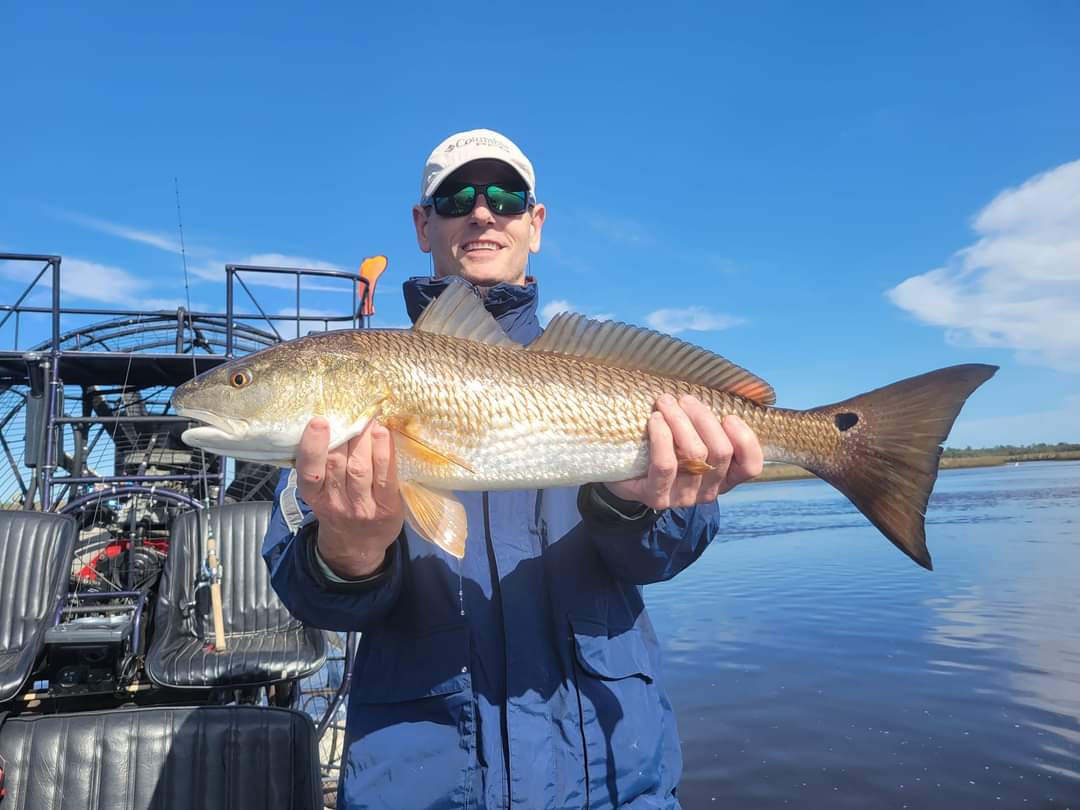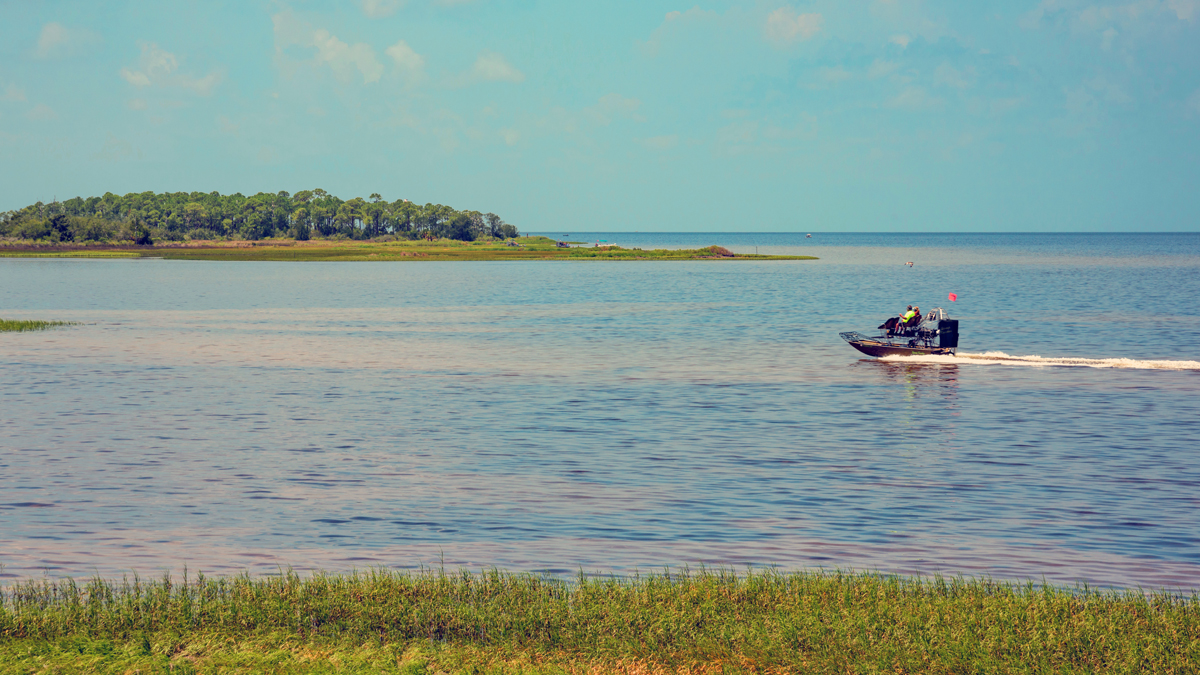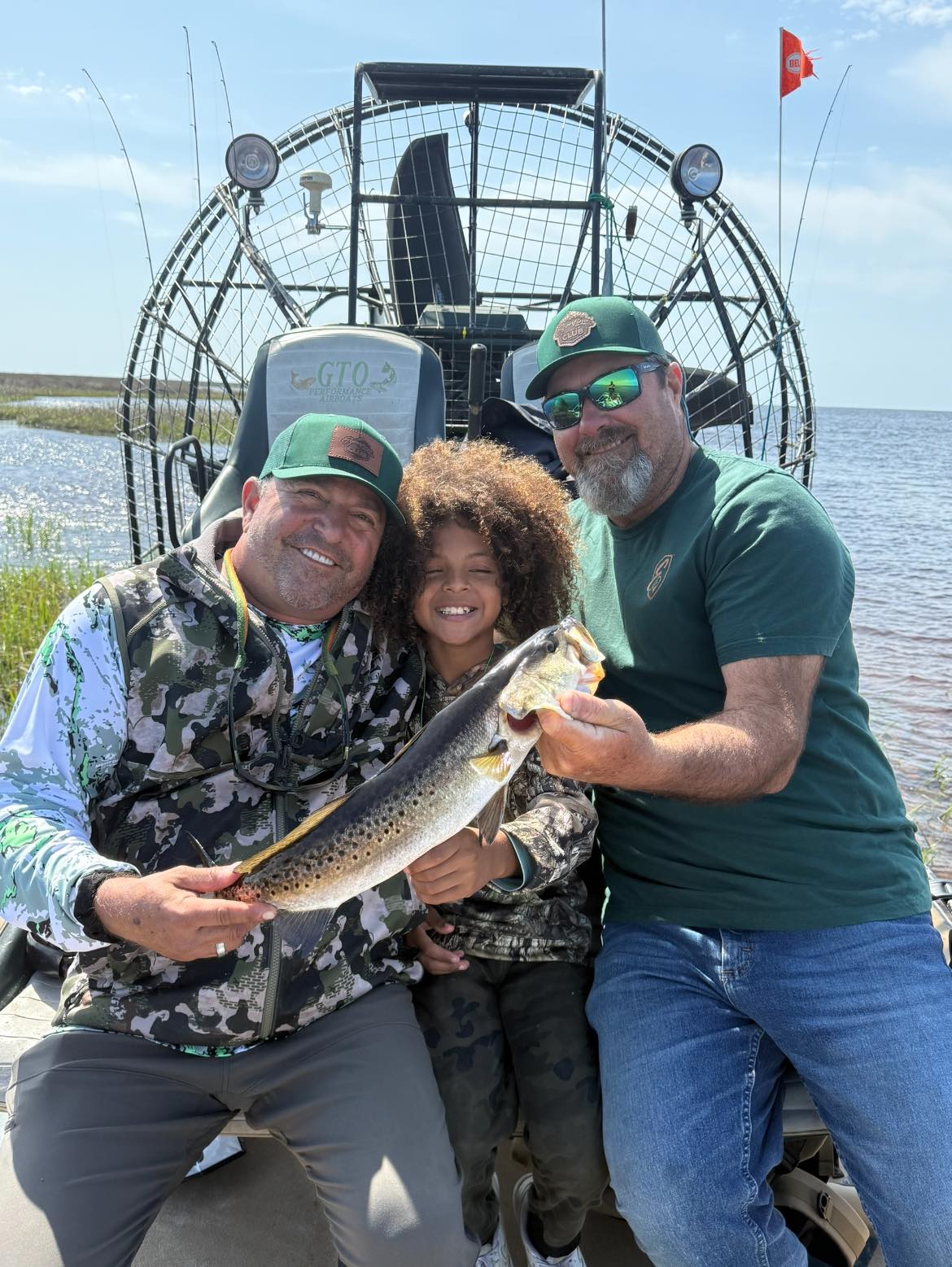The inshore terrain across North Florida is untamed and full of hidden structure. Creeks twist into marshes. Shallow lakes hold bait. Tidal cuts flush water through shell banks and grass lines. Airboats turn this complex landscape into reachable water. They carry fishermen directly into systems where other boats stop short.
A trip begins with noise and speed but transitions immediately into stillness. As soon as the fan shuts down, the marsh reveals everything: tails, pushes, bait flashes, and shadows gliding just beneath the surface. No scouting or idling required. The moment begins right there.
The Advantage Is Access
Shallow mud, thick vegetation, and oyster-studded flats block most boats from going beyond the main arteries of the marsh. Airboats slide through all of it. They cover long distances quickly and set down directly in target zones. With no submerged propeller and minimal draft, they reach areas that rarely see pressure.
Each launch places you in striking distance of clean grass, structure lines, and bait-rich water. Oyster points become reachable. Narrow creek mouths become staging grounds. The time between arrival and action is measured in seconds. Fish behavior often remains unchanged because the approach leaves no disturbance once the fan is off.
This level of access defines every trip. Success begins at the first stop because the fish are already there.
Conditions Shape Every Move
Marsh behavior changes with every tide and weather shift. Rising water pushes redfish and drum into flooded grass and shoreline cover, while falling water pulls them to creek mouths and exposed shell. Each stage controls where fish feed and how long they stay there.
Wind alters clarity and bait position. A southeast breeze might gather surface activity into corners, while a stiff north wind can expose structure and drop water levels. These shifts change how and where the boat sets up.
Light levels affect visibility and presentation. Bright skies call for longer leaders and subtle retrieves. Low light or overcast may open surface bites and keep fish active in open water.
Temperature and salinity drive species changes. Warm water increases movement in redfish, gar, and bowfin. Cold fronts send fish into troughs. Freshwater inflow pushes bass into marsh pockets. Dry spells often pull reds and sheepshead farther back into brackish systems.

The Species You’ll Actually Find
Marsh systems in North Florida are home to both saltwater and freshwater species. Brackish overlap creates a unique fishery where redfish mix with bowfin, and sheepshead might feed within sight of largemouth bass. This diversity builds each day into a multi-species experience with shifting opportunity based on time, zone, and tide.
Redfish (Red Drum)
Redfish tail through grass, push bait across flats, and hunt oyster structure during current swings.
Quick Facts
- Found in most marsh zones year-round, especially strong in fall
- Typical size is 18–30 inches; larger bulls more common September through November
- Hit spoons, soft plastics, topwater, and cut bait fished near drains and grass
Black Drum
These crustacean-focused bottom feeders hold tight to structure, especially during cooler months.
Quick Facts
- Present near oyster mounds, channel bends, and current seams
- Commonly weigh 3–10 pounds, sometimes topping 20
- Best caught with dead shrimp, crab chunks, or natural jigs dragged slowly on bottom
Spotted Seatrout (Speckled Trout)
Trout suspend near current breaks and shell beds and often attack aggressively in low light.
Quick Facts
- Peak activity in spring and fall; hold near shell and deeper cuts
- Typical size 14–20 inches; large trout over 24 inches appear around cold fronts
- Respond to suspending plugs, twitch baits, and soft plastics on light leader
Longnose Gar
Gar cruise brackish and stillwater edges, surfacing often and striking hard.
Quick Facts
- Most visible in late spring through early fall in creeks and stagnant marsh pockets
- Average 2–4 feet long; 5–15 pounds common
- Require rope lures or carefully rigged bait under cork for effective hookup
Bowfin (Mudfish)
Bowfin stay low in the water column and strike from cover without warning.
Quick Facts
- Found in freshwater-fed marsh arms and overgrown creek fingers
- Range from 3–8 pounds; fights include rolls, head shakes, and powerful turns
- Effective presentations include spinnerbaits, live bait, or dark soft plastics near cover

Largemouth Bass
Bass follow freshwater lines and ambush prey near structure and shade.
Quick Facts
- Most active spring through fall in creeks and sloughs with lower salinity
- Size typically 1–4 pounds with higher average in remote systems
- Common tactics include frogs, soft jerkbaits, and spinnerbaits along submerged edges
Sheepshead
These fish feed along hard edges and submerged structure, often requiring subtle presentation.
Quick Facts
- Best targeted in late winter and early spring
- Average between 12 and 16 inches; some fish exceed 18
- Require fiddler crabs, shrimp, or small jigs placed precisely near pilings or rock
Others to Expect
- Flounder often appear in creek mouths with sandy bottom during fall tides
- Juvenile tarpon roll in deeper sloughs during late summer heat
- Blue and channel catfish hold in brackish-fresh transitions
- Mullet provide active surface signs and sometimes trigger opportunistic strikes
These supporting species contribute to the variety and unpredictability of the day.
Reading Seasonal Shifts
Each season creates new opportunities. Spring warms up the grass and brings more movement through shell beds. Summer expands the system with flooding tides and spreads fish across grass flats. Fall compacts the bait and triggers more aggressive movement through tighter zones. Winter strips back the vegetation, increases clarity, and highlights structure that had been hidden all year.
Each trip builds from these seasonal cues. Water temperature, tide flow, and sun angle guide decisions about which zones to approach first and how to work them. Seasonal changes affect not just where fish are, but how they behave in specific parts of the system.

What the Day Actually Feels Like
The trip starts early. The sun may just be breaking the treeline, or the marsh might still sit in low gray light. The airboat roars to life, lifts across the mud, and covers more distance in minutes than most boats manage all morning. Once the fan cuts and the hull slides to a stop, the silence takes over completely.
From that point on, the pace turns deliberate. You might push off on foot into grass-lined banks, or ease along a drift line while scanning for movement. The boat may stay parked for two hours in the right spot if the tide is working in your favor. It may also reposition multiple times to keep pace with redfish moving through a series of cuts.
Expect stretches of stillness broken by short bursts of chaos: an explosion on topwater, a hard pull through the grass, or a sudden hook-up from a fish that had been sitting quietly under the edge. You’ll cast into water that feels untouched because it is. The marsh remains wild in these spots, and the fish behave like it.
This kind of trip fits naturally into the broader experience we offer at Econfina Sports Club. Based along the Econfina River and rooted in the same landscape these airboats run, our lodge and guide service covers everything from inshore stalking to deep-water offshore charters. Whether you’re chasing bull reds, largemouth bass, wild hogs, or amberjack, we run trips that match the season and the conditions.
Some guests visit for a single outing. Others stay the week and split their time between hunting bottomland hardwoods and fishing the flats at first light. We provide full lodging, meals, and charter access for both hunting and fishing year-round. Airboat fishing is one part of what this stretch of Florida offers, and we’re here to guide every piece of it. Book a trip with Econfina Sports Club and start planning your stay today.


